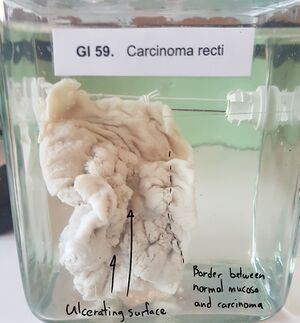40. Rectal adenocarcinoma
Organ: Rectum
Description:
Most of the mucosa is overtaken by a cancer. The cancerous part has irregular and slightly greyish surface, while the healthy mucosa is more regular and is slightly more whitish.
Diagnosis: Rectal adenocarcinoma
Risk factors:
- Ulcerative colitis
- Bad diet
Theory:
The adenocarcinoma is ulcerated at the deepest point, however that is not easily visible on the picture. The difference in colour between the healthy and cancerous tissue isn’t great due to the formalin fixation.
Colorectal cancers have different symptoms depending on their location.
If they occur on the right side of the body (mostly the ascending colon) will the symptoms be:
- Weight loss
- Occult (invisible) bleeding
- Leads to fatigue
If colorectal cancer occurs on the left side (mostly the descending and sigmoid colon) will the symptoms be:
- Alternating diarrhoea and constipation
- Palpable nodule
- Haematochezia
- Ileus
The differences in the symptoms can be attributed to how the ascending colon has a larger diameter than the descending.

